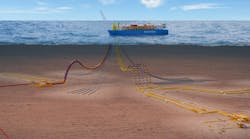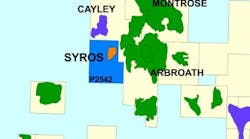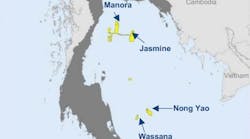New tool ensures proper placement
M.L. Connell
R.G. Howard
Halliburton Energy Services
The use of coiled tubing to fracture wells is relatively new and ideally suited for some fields. The limiting factor for well stimulations has been the size and strength of the coiled tubing itself. As tubing has grown larger and more robust, the opportunities for using coiled tubing have expanded. Nowhere is this more evident than in coiled-tubing fracturing operations.
As fatigue life and strength have improved for large-diameter coiled tubing over the last few years, the economics of fracturing wells with coiled tubing have also improved. Previously, the short life of large coiled tubing made such operations impractical.
With coiled tubing, wells can be fractured in a much shorter time than with conventional methods. Often, the fracturing job can be completed in one day using coiled tubing. This is possible because the coiled tubing can reposition the packers quickly from one zone to the next and can do this in an underbalanced condition. Conventional fracturing operations with jointed pipe on a rig require that the well be in an overbalanced state before moving the tools to the next zone in the well.
The techniques used in coiled-tubing fracturing (CTF) are similar regardless of the field. A large-diameter coiled-tubing string is needed to achieve sufficient flow rates to properly fracture the zones. Most coiled-tubing strings being used are 2 3/8-in. or 2 7/8-in. diameter. Most of the coiled-tubing units (CTUs) have an integral mast or derrick that supports the injector head and the lubricator. A lubricator is used so that the tools can be retrieved from the well in an underbalanced condition.
null
- Equalizing valve – Allows pressure equalization before the packer is released and moved to the next zone
- Lower slip design – Does not require rotation of the outer mandrel to release, making packer unsetting easier
- Cup top packer – Allows reverse circulation while running inhole for washing debris
- Multiset – Capable of being set, unset, and moved many times reliably.
Standard BHPA operating procedure calls for reverse circulating while tripping in the well. This helps reduce the friction between the top cup packer and the casing wall. The reverse circulation also enables well cleanup to remove formation fines that have migrated into the well after perforating.
Once the tool string is located at the first zone to be fractured, the packer is set by first picking up 2 ft and then setting weight down on the BHPA. The lower slips will anchor to the casing wall and the lower packer element will seal in the wellbore. At this point, the CTF operation can begin. After the fracture stage is complete and the zone is allowed to flow back, the packer can be released by picking up with the coiled tubing and moving to the next zone.
Coiled tubing depth control
The derrick height of the CTU dictates how much of the lubricator can be run below the injector head. In most instances, the length of the lubricator will limit the straddle length to about 25 ft. Typical zone candidates for CTF operations range from 5 to 20 ft thick. When fracturing a 20-ft zone with a 25-ft straddle packer, there is only 2.5 ft of tolerance on either side of the zone.
Most of the toolstrings being used for CTF operations consist of some type of straddle packer.Working with close-tolerance depth bands has been a problem for coiled tubing. Most CTUs use either a simple wheel counter or an optical encoder, or a combination of both, to keep track of the amount of coiled tubing that has been inserted into the well.
It is important to note that even if the CTU depth counters worked perfectly and always measured the exact amount of coiled tubing conveyed into the well, there can still be depth discrepancies between the wireline logs and the coiled-tubing toolstring.
Collar locators
To address the inefficiencies of existing coiled-tubing depth counters, wireless casing collar locators (WCCLs) were developed about three years ago. These tools are battery-powered devices that indicate the location of casing collars, tubing collars, or other types of jewelry by sending a pressure pulse to the surface as the tool travels through the well. No cable is required for power or data transmission.
Once the depth counter adjustments are satisfied, the WCCL can be switched from the logging mode to allow flow out of the bottom of the tool. During logging, the WCCL has a sliding sleeve that blocks all flow from exiting the bottom of the tool. This feature was designed into the tool as a precaution to help prevent pressure surges from contacting pressure-activated firing heads in tubing-conveyed perforating guns.
Once the logging passes are finished, a ball is dropped to a seat in the tool and pressure is applied to shear some of the pins and shift the sleeve. When the sleeve shifts, all flow through the logging nozzle port is blocked and the fluid is routed through small ports to the bottom of the tool. Perforating or plug-setting operations can begin at this time.
The WCCL tools were developed primarily for depth control before setting plugs or perforating. They are limited to flow rates well below normal fracturing rates. Additionally, the flowpath through the two existing WCCL tools follows a somewhat tortuous route, which is not desirable when pumping sand slurries. To have a WCCL that is suited to CTF operations, a new design was necessary.
Large bore WCCL
Based on CTF operational experience and field experience with existing WCCL tools, the following parameters were established for a new tool:
- Bore size must be large enough to handle 12 bbl/min of sand-laden fluid
- Must allow reverse circulation while running in the well
- Must be rated to 300° F and 15,000-psi bottomhole pressure
- Does not require a ball drop to switch from logging to fracturing mode
- Capable of working in casing as small as 4 1/2 in.
Tool operation
To allow for reverse circulation while running in the well, a flapper was placed into the lower end of the tool. The flapper swings up as fluid enters the bottom of the WCCL and closes whenever reverse circulation stops.
null
As with previous WCCL tools, when a collar is detected, the solenoid valve opens and routes fluid in above the sliding piston. The piston travels down sufficiently to cover the exit port and then retracts when the solenoid is de-energized.
When the logging portion of the CTF job is complete and the coiled-tubing depth counter has been corrected, fracturing can begin by switching the tool from logging mode to fracturing mode. Previous WCCL tools required a ball to be dropped from the surface to shift modes.
The tool can be switched to the fracturing mode by a sleeve that is held in place with shear pins. To shear the pins, the pump rate is increased from the normal logging rate of 1 to 1.75 bbl/min to 3 to 4 bbl/min.
null
The first large-bore WCCL tools were assembled in 3Q 2001. Lab testing started immediately to check for proper tool function in the logging mode. Once that phase of the testing was complete, the sliding sleeve/rupture disc feature was tested to ensure that the tool would switch modes as designed. Finally, the tools were tested on a flow loop with sand-laden fluids at 12 bbl/min. Some refinements were made at this point to increase part life in the lower section of the tool.
Based on initial field operations, tool designers are optimistic about the large-bore WCCL's performance. Enhancements to the tool, including better filtration and more reliable solenoid valves, have been implemented and have dramatically increased the tool reliability.
Conclusion
The need for proper straddle packer placement led tool designers to develop a tool for use in CTF operations. A battery-powered depth-control tool was developed for fracturing operations that incorporates the following features:
* Reverse-circulation while running in the well
* Logging casing collars in real time for correlation to wireline logs
* After correlating and correcting the CTU counters, the tool can be switched from the logging mode to an unrestricted ID for fracturing without the need of dropping a ball
* All of these functions can be accomplished in a single trip in the well, saving time and money for the operating company.
References
McConkey, S. and Stromquist, M.: "Integration of Conventional Fracturing, Coiled Tubing, and Retrievable Tool Technology" paper SPE 60709.
Rodvelt, G., et al. "Multiseam Coal Stimulation Using Coiled-Tubing Fracturing and a Unique Bottomhole Packer Assembly" paper SPE 72380.
Pessin, J.L. and Boyle, B.W.: "Accuracy and Reliability of Coiled Tubing Depth Measurement" paper SPE 38422.
Connell, M.L.: "Refining Coiled Tubing Depth Control," paper presented at the 1993 North American Conference on Coiled Tubing and Applications, Calgary.
Connell, M.L., Howard, R.G., Moore, D.W.: "Development of a Wireless Coiled-Tubing Collar Locator," SPE paper 54327 presented at the 1999 International Coiled Tubing Roundtable, held in Houston, Texas.
Editor's Note: This a summary of SPE 74834.








